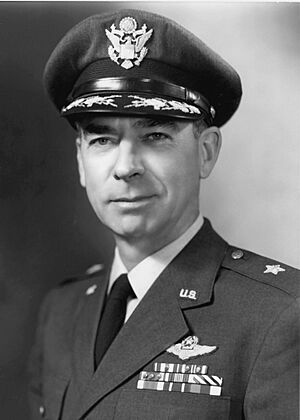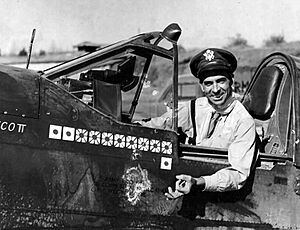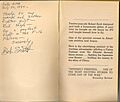Robert Lee Scott Jr. facts for kids
Quick facts for kids
Robert Lee Scott Jr.
|
|
|---|---|
 |
|
| Nickname(s) | "Scotty" |
| Born | 12 April 1908 Waynesboro, Georgia, U.S. |
| Died | 27 February 2006 (aged 97) Warner Robins, Georgia, U.S. |
| Buried | |
| Allegiance | United States |
| Service/ |
United States Army Air Corps United States Army Air Forces United States Air Force |
| Years of service | 1932–1957 |
| Rank | Brigadier General |
| Commands held | 23rd Fighter Group 36th Fighter-Bomber Wing Luke Air Force Base |
| Battles/wars | World War II |
| Awards | Silver Star (2) Distinguished Flying Cross (3) Air Medal (4) Army Commendation Medal |
| Other work | Author |
Robert Lee Scott Jr. (born April 12, 1908 – died February 27, 2006) was a brave pilot and a brigadier general in the United States Air Force. He was a "flying ace" during World War II, meaning he shot down many enemy planes. He is famous for taking down 13 Japanese aircraft.
Scott is also well-known for his book, God is My Co-Pilot. This book tells the exciting story of his adventures during World War II. He flew with the Flying Tigers and the United States Army Air Forces in places like China and Burma. His book was even made into a movie in 1945.
Early Life and Dreams
Robert Scott Jr. was born in Waynesboro, Georgia. He was the oldest of three children. As a young boy, he went to school in Macon, Georgia.
Scott was a very active youth. He became an Eagle Scout, which is the highest rank in Boy Scouts. When he was only five years old, he saw a plane crash. This sad event made him very interested in flying. He later got the chance to attend West Point, a famous military school.
Becoming a Military Pilot
After finishing school at West Point in 1932, Scott began his pilot training. He learned to fly at Kelly Field in Texas. In 1933, he was sent to Mitchel Field in New York.
Scott had many flying jobs early in his career. He even flew air mail in 1934, delivering letters by plane. He also led a group of fighter planes in Panama. Later, he helped teach other pilots at bases in Texas and California.
Heroic Flights in World War II

When World War II started, Scott wanted to join the fight. In 1942, he joined a special group called Task Force Aquila. Their mission was to fly Boeing B-17 Flying Fortress bombers to the China Burma India Theater. He even pretended to be an expert B-17 pilot to join, learning to fly the plane on the way to Africa!
Once he arrived in India, the bombing mission was canceled. Scott was eager to get into combat. He soon became an officer for the Assam-Burma-China (Ferry) Command. This group later became the famous Air Transport Command. They flew supplies over "The Hump" from India to China.
Scott really wanted to fly in combat. He learned tactics from the famous Flying Tigers pilots. He even flew a Republic P-43 Lancer on a high-altitude mission over Mount Everest. He wrote about this in his book, God Is My Co-Pilot. Scott then started flying missions with the Flying Tigers in a P-40 plane. He would often fly alone, escorting transport planes or attacking targets on the ground. He even painted his plane's propeller in different colors. This made it look like there were more fighter planes in the sky than just his one! He was like a "one-man air force."
In July 1942, Scott became the commander of the 23rd Fighter Group. This group was formed by General Chennault after the Flying Tigers ended their contracts. The 23rd Fighter Group later became part of the 14th Air Force.
Colonel Scott flew 388 combat missions. He spent 925 hours flying between July 1942 and October 1943. During this time, he shot down 13 Japanese aircraft. This made him one of America's first "flying aces" of the war.
In October 1943, Scott was sent back to the U.S. He worked at the Army Air Force School in Florida. His book, God Is My Co-Pilot, was published that year. It became very popular and was made into a movie in 1945.
Scott returned to China in 1944. He flew fighter planes that had special rockets. He used them to attack Japanese supply trains. As the war ended, he moved to Okinawa to direct similar attacks against enemy ships.
Besides God Is My Co-Pilot, Scott also wrote other books. One was called Damned to Glory (1944). It had many exciting World War II stories. One story, "Ghost Ship," was even printed in Reader's Digest. However, Scott later said he and another pilot made up that story as a joke!
Life After the War
After World War II, Scott worked in Washington, D.C. In 1947, he took command of the Jet Fighter School in Arizona. In 1951, he moved to West Germany. There, he commanded the 36th Fighter-Bomber Wing.
Scott retired from the Air Force as a brigadier general on September 30, 1957. He lived in Arizona for many years. Later, he moved to Warner Robins, Georgia, where he passed away in 2006. General Scott wrote about a dozen books in total, including The Day I Owned the Sky.
Scott stayed very active even after retiring. In 1980, he hiked the entire length of the Great Wall of China. He had seen parts of the Wall during his flights in 1944. It took him 94 days to complete the 1,900-mile trek!
Scott continued to fly even as an older man. In 1984, he flew in an General Dynamics F-16C Fighting Falcon. He also flew in a McDonnell Douglas F-15 Eagle. On his 89th birthday in 1997, Scott flew in a B-1B Lancer bomber.
Robert Lee Scott Jr. died on February 28, 2006. He was buried with full military honors at Arlington National Cemetery.
Awards and Honors
For his amazing service in World War II, Scott received many awards:
 |
|||
| USAF Command Pilot badge | |||||||||||
| Silver Star w/ 1 bronze oak leaf cluster |
|||||||||||
| Distinguished Flying Cross w/ 2 bronze oak leaf clusters |
Air Medal w/ 3 bronze oak leaf clusters |
Army Commendation Medal | |||||||||
| American Defense Service Medal | American Campaign Medal | Asiatic-Pacific Campaign Medal w/ 1 silver campaign star |
|||||||||
| World War II Victory Medal | Army of Occupation Medal | National Defense Service Medal | |||||||||
| Air Force Longevity Service Award w/ 1 silver oak leaf cluster |
Distinguished Flying Cross (United Kingdom) |
Army, Navy & Air Force Medal A1 (Republic of China) |
|||||||||
| Order of the Sacred Tripod 6th Grade (Republic of China) |
Order of the Cloud and Banner 4th Grade (Republic of China) |
China War Memorial Medal (Republic of China) |
|||||||||
During the 1996 Summer Olympics in Atlanta, Georgia, Scott carried the Olympic Flame. He carried it along a road named in his honor. In 1989, he was one of the first people to be put into the Georgia Aviation Hall of Fame.
Books by Robert Scott
- God is my Co-Pilot. New York: Blue Ribbon Books, 1943.
- Damned to Glory. New York: Blue Ribbon Books, 1944.
- Runway to the Sun. New York: Charles Scribner's Sons, 1945.
- Between the Elephant's Eyes. New York: Dodd Mead, 1954.
- Look of the Eagle. New York: Dodd Mead, 1955.
- Samburu the Elephant. New York: Dodd, Mead, 1957.
- Tiger in the Sky. New York: Ballantine Books, 1959.
- Boring a Hole in the Sky: Six Million Miles with a Fighter Pilot. New York: Random House, 1961.
- God is Still My Co-Pilot. Garden City, N.Y., Blue Ribbon Books, 1947.
- Flying Tiger: Chennault of China. Westport, Connecticut: Greenwood Press, 1973. ISBN: 0-8371-6774-4
- "To Walk the Great Wall". Reader's Digest, April 1983
- The Day I Owned the Sky. New York: Bantam Books, 1989. ISBN: 0-553-27507-0
Images for kids
-
Plaque of Scott at the Georgia Aviation Hall of Fame
-
Painting of Scott at the Museum of Aviation







